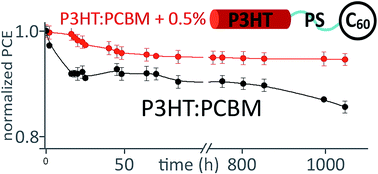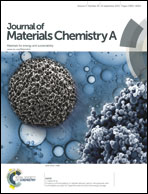Fullerene-capped copolymers for bulk heterojunctions: device stability and efficiency improvements†
Abstract
A fullerene end-capped polymer-compatibilizer based on poly(3-hexylthiophene) (P3HT) was synthesized and demonstrated to have a remarkable effect on both the stability and efficiency of devices made from exemplar P3HT and [6,6]-phenyl C61-butyric acid methyl ester (PCBM). P3HT with ethynyl chain-ends and α-azido-ω-bromo-PS were prepared via Grignard metathesis (GRIM) and atom transfer radical polymerisation, respectively. “Click” chemistry resulted in the preparation of poly(3-hexylthiophene)-block-ω-bromo-polystyrene (P3HT-b-PS-Br), and subsequent atom transfer radical addition chemistry with fullerene (C60) yielded the donor–acceptor block copolymer P3HT-b-PS-C60. Both P3HT-b-PS-Br and P3HT-b-PS-C60 were considered as compatibilizers with P3HT/PCBM blends, with the study detailing effects on active-layer morphology, device efficiency and stability. When used at low concentrations, both P3HT-b-PS-Br (1%) and P3HT-b-PS-C60 (0.5%) resulted in considerable 28% and 35% increases in efficiencies with respect to devices made from P3HT/PCBM alone. Furthermore, P3HT-b-PS-C60 (0.5%) resulted in an important improvement in device stability.


 Please wait while we load your content...
Please wait while we load your content...